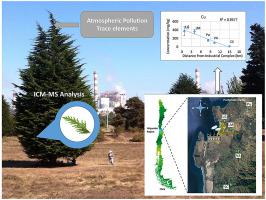Chemosphere ( IF 8.1 ) Pub Date : 2020-07-06 , DOI: 10.1016/j.chemosphere.2020.127521 Tamara Gorena 1 , Ximena Fadic 1 , Francisco Cereceda-Balic 2

|
The Punchuncaví Valley is one of the most polluted areas in central Chile affected by anthropogenic emissions from the Ventanas Industrial Complex (IC) where the most important industry is the copper smelter and refinery. In this context, this research aims were to assess the usefulness of the Cupressus macrocarpa as a biomonitor. The leaf samples were taken from five selected sites, located between 0.8 and 15 km away from the source. A total of 34 elements were analyzed in leaf samples by ICP-MS and examined by enrichment factor (EF), hierarchical cluster analysis (HCA), and principal component analysis (PCA). Leaf concentration of As, Ca, Cd, Cu, Dy, Er, Gd, K, Li, Mg, Mn, Mo, Na, Nd, P, Pb, Pr, S, Sb, Sr, Ti, Yb and Zn showed statistically significant differences between sampling sites (p-value < 0.05). A clear trend to increase the concentration of Cu, Sb, S, As, Cd and Pb with the proximity to the IC. Besides, high values of Cu (93.4–369 mg kg−1) and As (7.6–12.7 mg kg−1) were observed near to industrial area exceed the phytotoxic levels reported in plants with EF > 3000% for Cu and >1300% for As. The application of PCA and HCA identified 6 factors related to the industrial complex, traffic and geogenic sources, providing the greatest variance the component related to industrial activity mainly with copper smelter and refinery. According to the results, the C. macrocarpa leaves are a good biomonitor to evaluate the high pollution load for anthropogenic elements in industrial areas.
中文翻译:

柏树叶子用于生物监测工业园区对环境的影响:以智利Puchuncaví-Ventanas为例。
Punchuncaví山谷是智利中部受污染最严重的地区之一,受到Ventanas工业园区(IC)人为排放的影响,其中最重要的行业是铜冶炼厂和精炼厂。在这种情况下,本研究的目的是评估柏树的有用性。作为生物监测者。叶片样品是从距离源头0.8至15公里的五个选定地点采集的。通过ICP-MS对叶片样品中的总共34种元素进行分析,并通过富集因子(EF),层次聚类分析(HCA)和主成分分析(PCA)进行检查。叶片中As,Ca,Cd,Cu,Dy,Er,Gd,K,Li,Mg,Mn,Mo,Na,Nd,P,Pb,Pr,S,Sb,Sr,Ti,Yb和Zn的浓度采样点之间存在显着差异(p值<0.05)。一个明显的趋势是随着靠近IC的增加,Cu,Sb,S,As,Cd和Pb的浓度增加。此外,高的铜含量(93.4–369 mg kg -1)和砷(7.6–12.7 mg kg -1)在工业区附近观察到)超过了植物中报道的植物毒性水平,其中EF> Cu大于3000%,As大于1300%。PCA和HCA的应用确定了与工业园区,交通和地源有关的6个因素,其中与工业活动有关的主要成分(主要是铜冶炼厂和精炼厂)的差异最大。根据结果,大果念珠菌叶子是评估工业区人为因素高污染负荷的良好生物监测器。











































 京公网安备 11010802027423号
京公网安备 11010802027423号